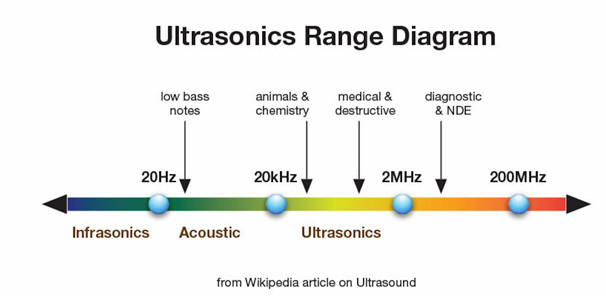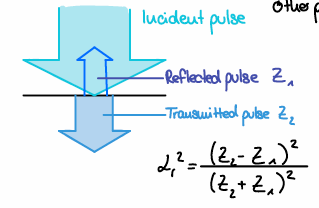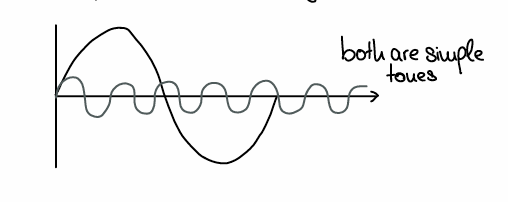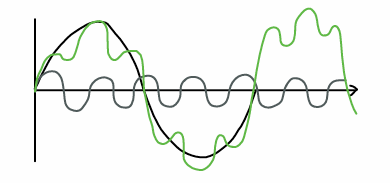Mechanical waves
1/22
There's no tags or description
Looks like no tags are added yet.
Name | Mastery | Learn | Test | Matching | Spaced |
|---|
No study sessions yet.
23 Terms
Mechanical wave
A spreading disturbance (forced displacement of particles) in elastic medium- MW transfers energy but not mass
MW may take a form of an elastic deformation in solids or a variation of pressure in gases
What is sound?
Any MW/mechanical vibration producing hearing perception

Acoustic spectrum, freq ranges
Infrasound → MW with frequency below 20Hz
Acoustic range → 20Hz - 20kHz
Ultrasound → High frequency above 20kHz
When can sound propagation occur? NB!
In elastic media only. The vibrations in elastic matter are transmitted consecutively from particle to particle causing recurrent alteration of density
Physical characteristics of sound (6):
Sound intensity (I)
Sound pressure (P)
Sound frequency (f)
Sound velocity (SV)
Sound wavelength (λ)
Acoustic impedance
Sound intensity (I)
The average sound energy transmitted per sec through unit area, perpendicular to the direction of sound propagation.
It quantifies the loudness of a sound at a given location.
Sound intensity : I = E/t.s
I - sound intensity (W/m2)
E - energy transferred by sound wave, joules (J)
t - time over which energy is transferred, seconds (s)
s - surface area through which sound wave passes (m2)
Sound pressure (P)
The sound force (N) acting on the surface area (m2) perpendicular to the sound direction
Sound pressure : p = Δpsin(φ)
p - instantaneous sound pressure at a particular point in the space at a given time, pascals (Pa)
Δp - peak sound pressure (maximum pressure), pascals (Pa)
sin(φ) - phase angle of the sound wave at a given point in space and time
How to calculate peak sound pressure (Δp)
If you know the sound intensity (I) :
I = Δp2 / 2ρc Rearrange → Δp = √2Iρc I - sound intensity, W/m2 Δp - peak sound pressure, Pa ρ - density of medium (kg/m3) c - speed of sound in medium (m/s)
If you know particle velocity (v) :
Δp = ρcv
v - peak particle velocity (m/s)
From the acoustic impedance :
Δp=zv
z = acoustic impedance (Pa·s/m) v = peak particle velocity (m/s)

Sound frequency (f)
Number of vibration per sec, measured in Hertz (Hz) Sound depends on physical properties of medium (density, temp, elasticity etc.) NOT on the frequency
Quantity related to f is the period - T = (1/f)
Sound velocity (v)
Quantity which depends on the properties of the medium through which sound propagates, dependent on the elastic properties and density of the medium
Sound wavelength (λ)
Distance between two consecutive sound fronts, measured in metres
Wavelength (λ)= Wave velocity (v) ⋅ Time period (t)
Wavelength (λ)= Wave velocity (v) / Frequency (f)
λ - meters (m) v - m/s t - seconds (s) f - Hertz (Hz)
Acoustic impedance (z)
Sound propagation through a certain medium is determined from z, when sound wave encounters a border between two different media - one part of wave reflects, the other part passes due to differences in acoustic impedances Z1 & Z2.
Acoustic impedance (z) = p (density of medium) x v (sound velocity)

Two types of sound
Complex & simple tone

Simple tones
a.k.a pure tone - sound wave with a single frequency.
Vibration should have a sine wave & possesses a certain frequency.
Contains no overtones or harmonics
Examples : electronically generated beep

Complex tones
Consists of multiple frequencies, several simple tones.
Waveform appears jagged/irregular
Examples : human voice, musical instrument
Psychophysical characteristics (5)
These are subjective, they are measurements of sounds perceived by the human ear.
Sound intensity level E
Audibility area
Sound pitch
Timbre
Loudness level
Sound intensity level (E)
Logarithmic measure of the intensity of sound relative to a reference intensity.
Measure in decibels (dB), E is defined at 1000Hz sound frequency only.
E = k(10) ⋅ log10(I/I0)
E - sound intensity level, dB
k - coefficient, bel = 1, dB = 10
I - sound intensity, W/m2
I0 - threshold of hearing, 10-12 W/m2
Loudness of sound (L)
Quantity representing human subjective perception of sound magnitude
L= k ⋅ log10(I/I0)
L - sound loudness, Phon
k - coefficient depend on frequency, 10
I - sound intensity, W/m2
I0 - threshold of hearing, 10-12 W/m2
Audibility area
Are between threshold of audibility and threshold of pain/feeling
All sounds we perceive are inside this area
Our ears are sensitive to sound 1000-4000Hz
Human speech is spread over 400-1000Hz
Pitch
Corresponds to sound frequency. Higher the frequency - higher the pitch.
Determined by vibrating c/stics of vocal cords:
Men - 80-100Hz, low pitch
Women - 400-500Hz, high pitch
Timbre
Characterises complex sounds (sound colour)
Deep-water wave has a wavelength of 10.0 meters. If it travels at 3.0 m/s, what is the wave's period?
Period= wavelength/speed
Period= (10.0 m)/(3.9 m/s)= 2.6 s